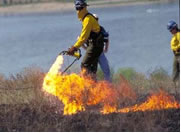MODULE 7 Forest Management Burning
Forest Management Burning
Forest management burning, also known as controlled, prescribed or hazard reduction burning, is a technique sometimes used in forest management, farming, prairie restoration or weed abatement. Fire is a natural part of both forest and grassland ecology and prescribed fire can be a great tool for foresters. Benefits of forest management burning include:
- Reduction in hazardous fuels, protecting human communities from extreme fires
- Minimizes the spread of pest insects and disease
- Removes unwanted species that threaten species native to an ecosystem
- Provides forage for game
- Improves habitat for threatened and endangered species
- Recycles nutrients back to the soil
- Promotes the growth of trees, wildflowers, and other plants
There are a few different types of forest management burning. Broadcast burning is the burning of scattered slash over a wide area, pile burning is the gathering up of the slash into piles before burning and creepy pile burning is letting gathered up slash piles burn and slowly creep through the forest burning years of built up leaf litter on the forest floor. Pile burning tends to have high temperatures which can harm soil, damaging it physically, chemically or sterilizing it. However, steps can be taken to restore soil after a pile burn. Broadcast burning tends to have lower temperatures and does not harm the soil as much as pile burning.

Specialists write burn plans and Smoke Management Plans for prescribed fires. Burn plans identify – or prescribe – the best conditions under which trees and other plants will burn to get the best results safely. Burn plans consider temperature, humidity, wind, moisture of the vegetation, and conditions for the dispersal of smoke. Prescribed fire specialists compare conditions on the ground to those outlined in burn plans before deciding whether to burn on a given day. The overall goal of a Smoke Management Plan is to protect public health by reducing smoke impacts in populated areas while protecting the vitality of California forests, other wild lands and farmland. California’s Smoke Management Program is designed to coordinate agricultural and prescribed burning among air districts, federal, state and local agencies, and private parties.
This completes the Forest Management Burning module.
If you have any questions, you can review this module at any time.
To check your understanding of this module, click the Test Yourself button below
Please sign in to enable the Test Yourself button.